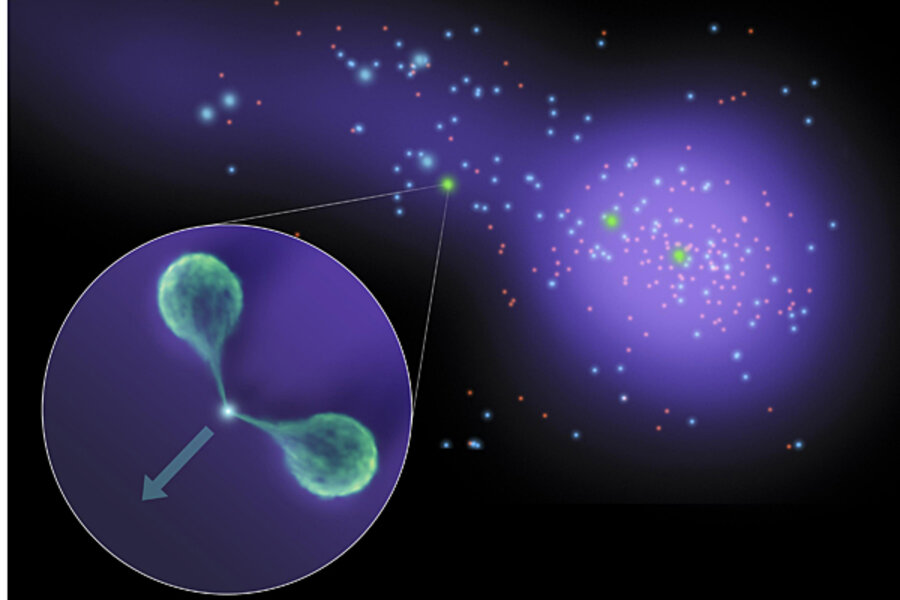Huge, boomerang-shaped galaxy spotted hurtling through space
Loading...
Astronomers have discovered an oddly bent galaxy that may help shed new light on how the most massive structures in the universe form and evolve.
The boomerang-shaped galaxy was found in a tendril of super-heated gas connecting two massive galaxy clusters. These tendrils — known as filaments — pervade the universe, joining galaxy clusters in an intricate latticework. Though immense, such filaments are tough to see and study in detail, researchers said.
In the new study, gas from a known filament was seen sweeping the previously unknown galaxy into its strange, bent shape. This suggests that similarly bent galaxies could serve as signposts for cosmic gas filaments, which themselves signify fertile star-forming regions, researchers said. [Illustration of the boomerang-shapedgalaxy.]
"These filaments are integral to the evolution of galaxy clusters -- among the biggest gravitationally bound objects in the universe -- as well as the creation of new generations of stars," said Louise Edwards, a postdoctoral researcher at the California Institute of Technology in Pasadena, Calif., in a statement. Edwards led the study that discovered the boomerang-shaped galaxy.
A strangely bent galaxy
The newfound galaxy resides in an intergalactic filament discovered in 2008 using NASA's Spitzer Space Telescope, which scans the universe in infrared light. The filament runs between two galaxy clusters called Abell 1763 and Abell 1770.
The new bent galaxy sits inside that filament, about 11 million light-years from the center of Abell 1763. Researchers discovered it using two different ground-based instruments — the WIYN Observatory near Tucson, Ariz., and the Very Large Array near Socorro, N.M.
The galaxy has an unusual ratio of radio to infrared light, which makes it stand out like a beacon to astronomers. This is due in part to its twin jets of material, which spew in opposite directions from a supermassive black hole at the galaxy's center, researchers said.
These jets have puffed out into giant lobes of material that emit a tremendous amount of radio waves, they added.
Edwards and her colleagues noticed that these lobes appear to be bent back and away from the galaxy's path through the filament. This bow shape is likely caused by particles in the filament pushing on the gas and dust in the galaxy's jet lobes.
By measuring the angle of the bent lobes, the team calculated the pressure exerted by the filament's particles and then determined the density of the medium. The method is similar to watching the streamers on a kite soaring overhead to judge wind strength and the thickness of the air, researchers said.
The density inside this filament is about 100 times the average density of the universe, researchers found. This value is similar to others obtained in a previous X-ray study of filaments, and it matches predictions by supercomputer simulations.
Edwards and her colleagues detail their research in the Dec. 1 issue of the Astrophysical Journal Letters.
Intergalactic superclusters
In general, galaxies observed in the universe have a tendency to bunch together in clusters. These galactic clusters, in turn, themselves clump near other clusters to form so-called "superclusters" that loom as huge, gravitationally linked walls of galaxies.
Clusters and superclusters evolved from denser patches of material as the universe rapidly expanded after the Big Bang, about 13.7 billion years ago, researchers said.
Over time, the clumps and threads of this primordial matter eventually cooled, condensing into the galaxies we see today. A lot of the leftover gas is strewn in the filaments between galaxy clusters, researchers said.
Much of this gas is still quite hot — about 1.8 million degrees Fahrenheit (1 million degrees Celsius) — and blazes in high-energy X-rays that permeate galaxy clusters. Filaments are therefore best detected in X-ray light.
But the X-ray-emitting gas in filaments is much more diffuse and weak than in clusters. Therefore, obtaining quality observations of filaments is time-consuming with current space observatories.
The technique used by Edwards and her colleagues, which uses radio frequencies that can reach a host of ground-based telescopes, points to an easier way to probe the interiors of filaments. So astronomers may be able to trust these boomerang-shaped "lighthouse" galaxies to identify where cosmic filaments lie, according to researchers.
Knowing how much material these filaments contain and how they interact with galaxy clusters will be very important for understanding the overall evolution of the universe, Edwards said.





